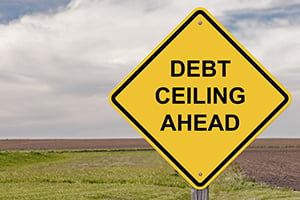 With the new Congress taking office—and specifically the extended time it took for the House Republicans to elect their new speaker—markets are increasingly focused on the potential effects of politics on the economy this year. I have had several questions about the debt ceiling in particular, so let’s take some time and think through what all of this might mean.
With the new Congress taking office—and specifically the extended time it took for the House Republicans to elect their new speaker—markets are increasingly focused on the potential effects of politics on the economy this year. I have had several questions about the debt ceiling in particular, so let’s take some time and think through what all of this might mean.
The Big Picture
We now have a narrowly Republican House of Representatives, a narrowly Democrat Senate, and a Democrat White House. This is an extreme form of divided government. Not only do the different parties each control a house of Congress, but the margins of control are narrow enough that divisions within the parties can affect the ability of Congress to get anything done. We have rarely seen this divided a government or one that will find it so hard to get anything significant done.
We saw this in the last Congress in the Senate, where the Democrats’ razor-thin majority meant one senator could torpedo any policy they didn’t like. With both Manchin and Sinema giving the White House heartburn, policy initiatives were regularly dialed down to what they would accept. We are seeing this now in the Republican House, and the results will very likely be the same. As a result, for anything at all to get through, it has to have the backing of pretty much everyone, meaning the possibility of legislation that makes any significant changes is dead for the next two years. What you see is what you get for federal policy.
On balance, this is a good thing for markets. Markets like certainty. With policies unlikely to change much, in many respects, they have just that. For things that don’t have to change, steady is good—and most things don’t really have to change. There is an upside here.
Why the Limit Needs to Be Raised
But some things do have to change, and this is where concerns are rising. The federal debt ceiling, which is the legal limit on how much the federal government can borrow, is regularly hit as the country borrows more and is just as regularly raised. But that raising requires Congressional action and approval. That is the one thing that has to happen this year, which the political divisions suggest may not happen. That is where the major economic and market risks from politics come from.
Why is it necessary to raise the limit? The first reason is that Congress has already authorized the spending. It makes no sense to say we will spend the money but we won’t do what it takes to spend the money. Second, and more impactful, not spending the money has immediate consequences: on people’s jobs and livelihoods, on national defense, on social security payments, and ultimately on the financial system itself. U.S. government debt is the ultimate low-risk asset. And if it doesn’t get paid? Then the whole financial system could be rocked. If the U.S. government chooses not to meet its obligation, that will rock both the economy and the markets. So, if that were to happen, there would be real risks and we should be watching them. But will that happen? Probably not.
We’ve Seen This Movie Before
While the risks are real, we have seen this movie before. Republicans regularly fight against raising the debt ceiling and occasionally succeed in shutting down the government. In 1995, 2011, 2013, and 2021, we saw iterations of this battle. In each case, we eventually saw a resolution that brought things back together, despite fears that this would be the time the system finally collapsed. Even if we do get a debt ceiling-driven shutdown this year, history suggests that it will be resolved before it becomes a real crisis.
Of course, past performance is no guarantee, as the saying goes, so we can’t count on that. But if Congress doesn’t act, there are still measures that can be taken. The trillion-dollar coin is one avenue, and there are others. No one wants to do that, but the lesson of the Great Financial Crisis and the pandemic is that when needed, the government can and will act to avert catastrophe and worry about cleaning up the mess later. The worst case is always possible, but it almost never shows up as long as the will and tools are available to avert it. And they are.
Watch the Cliff
And that is how I am looking at the economic and market risks of the current political dysfunction. The risks are real, but they are not new and have always been historically contained. If Congress does go off the rails, there are other measures that can be taken. In short, as long as we are watching the cliff—and we are—we will not end up driving off of it. By the way, while we focus on the risks, we also need to remember there are some positive aspects of this as well, which will show up once we do avert the disaster.
This debt ceiling problem is real, but it is not new and it is solvable. Keep an eye on it, but don’t worry about it. In other words (and once again), keep calm and carry on.


 Print
Print

